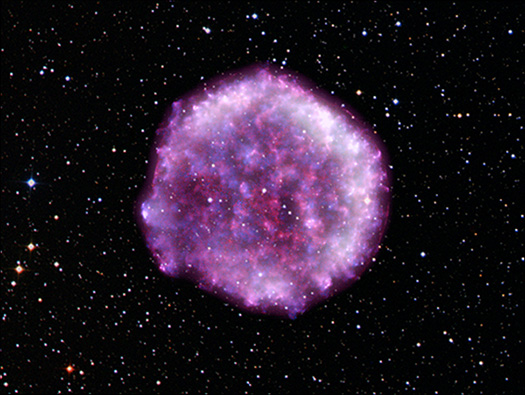Unlocking the Mysteries of the Historic Tycho Supernova

Tycho's Supernova Remnant
Credit: X-ray (IXPE: NASA/ASI/MSFC/INAF/R. Ferrazzoli, et al.), (Chandra: NASA/CXC/RIKEN & GSFC/T. Sato et al.) Optical: DSS, Image processing: NASA/CXC/SAO/K. Arcand, L. Frattare & N. Wolk
This image provides a new look at the Tycho supernova remnant, named for Danish astronomer Tycho Brahe who noticed the bright glow of this new “star” in the constellation Cassiopeia more than 450 years ago. Astronomers used NASA’S Imaging X-ray Polarimetry Explorer (IXPE) to study polarized light from Tycho, the debris from an exploded star, as described in IXPE’s latest press release. IXPE revealed, for the first time, the geometry of the magnetic fields close to the supernova’s blast wave, which is still propagating from the initial explosion and forms a boundary around the ejected material. Understanding the magnetic field geometry allows scientists to further investigate how particles are accelerated there.
In this composite image, data from IXPE (dark purple and white) have been combined with those from NASA’s Chandra X-ray Observatory (red and blue), which were overlaid with the stars in the field of view seen by the Digitized Sky Survey.
Chandra has repeatedly observed the Tycho supernova remnant over its decades of operations, helping researchers make landmark discoveries about this fascinating formation. With its ability to identify and track polarized X-ray light, IXPE builds on the groundwork laid by Chandra. A thin red line around the outside of the supernova remnant, seen in the Chandra data, shows where electrons have been accelerated to high energies by spiraling around magnetic fields lines and producing X-rays. This provides evidence that supernova remnants are a major source of energetic particles, including electrons and protons, which continually bombard Earth’s atmosphere.
The Tycho supernova is classified as a Type Ia. This violent explosion occurs when a white dwarf star in a binary system pulls material off its companion star until it reaches a mass limit, or when two white dwarfs merge. The obliteration of the white dwarf sends debris hurtling into space at tremendous speeds.
A paper describing these latest results on the Tycho supernova remnant, led by Riccardo Ferrazzoli of the Italian National Institute for Astrophysics in Rome, appears in the latest issue of The Astrophysical Journal and is available here.
IXPE is a collaboration between NASA and the Italian Space Agency with partners and science collaborators in 12 countries. IXPE is led by NASA’s Marshall Space Flight Center in Huntsville, Alabama. Ball Aerospace, headquartered in Broomfield, Colorado, manages spacecraft operations together with the University of Colorado's Laboratory for Atmospheric and Space Physics in Boulder.
NASA's Marshall Space Flight Center manages the Chandra program. The Smithsonian Astrophysical Observatory's Chandra X-ray Center controls science operations from Cambridge, Massachusetts, and flight operations from Burlington, Massachusetts.
